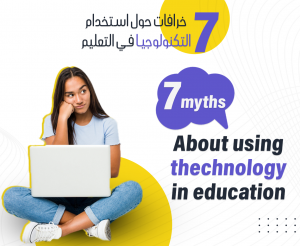Seven Myths About Using Technology In Education:
1.The First Myth:
The Targeted Group in Distance Learning is the Young.
In other words, technology in higher education, in particular, has become existed and all teachers have to make a clear and conscious transformation, despite their age and position. “Successful people are those who love and welcome change. ”The truth is that everyone – young and old, whether she/he knows using technology or doesn’t like using it has to be familiarized with distance learning.
2.The Second Myth:
Online Education Is Temporary :
Quite a few people would argue that Teaching Online is only
Is just a Temporary Arrangement at most for one or two semesters .Some teachers feel that when normal life returns ,she/he will return to chalk and talking to her/his students so that why should she/ he bother herself/himself in learning new teaching methodology The truth is Online Teaching has become really an essential part of our educational system and the changes are constant .
3- The Third Myth:
Online Education doesn’t achieve justice.
Some have argued that online education subtly favors those who have access to high technologies and rejects disadvantaged groups in society. There may be some truth
But the bigger truth is that online education is available for everyone
Therefore, those who claim that online teaching will increase the socio-economic gap between students is not justified .
It is true that in rural and semi-urban areas, high-speed of the internet is not always available but online teaching especially the asynchronous mode, will definitely help all students because of its flexibility .
4- The Fourth Myth:
Technology will eventually replace the teacher
The last two decades have brought about a conscious welcome to make the curriculum focused on student-centered. But this pandemic has brought about another very distinguished shift — a conscious and deliberate move toward technology. Earlier, teachers were synonymous with chalk, but now they are seen with laptops and mobile phones and this would sum up the change in pedagogy. There is an innate fear in teachers, especially those with outdated experiences, that technology will eventually replace them. Teachers should be reassured that they cannot be replaced, but they should also be told that their role has changed a lot. They were seen as repositories of knowledge. But now they are seen as curriculum designers, content developers, and knowledge sharers — all through means of technology.
5-The fifth Myth:
Students prefer face-to-face interaction :
This is an adequate form of resistance. Teachers who are not very comfortable with using technology and are hesitated to switch to online teaching , use the weak argument that their students prefer face-to-face interaction rather than online teaching. This stems from the wish that teachers are indispensable, and without them, the teaching and learning system would collapse. Young people are not only familiar with using technology but also willing to embrace change in any form. They are constantly on the lookout for new ideas and love to experiment and innovation , thus, they will not have major issues in switching to online education. Most students, if their destination is correct, will switch to online learning seamlessly and the ball is in the court of the education system, especially the teachers, to facilitate this smooth transition. And for these students, it’s not about either/or but about technology and teachers at the same time.
6- The Sixth Myth:
Online Education is not effective :
There are quite a few advantages in face-to-face classroom interaction; The most important of them is that teachers monitor what the student is learning, his mood, and his reaction, and unfortunately this feature is almost absent online. The educational content is often programmed and the method of learning is already stereotyped. Besides, how interested students are in online interaction, especially in asynchronous (not live) lessons, is unpredictable. Therefore, face-to-face interaction is said to be better than online education.
In fact, there are advantages and disadvantages in both directions. But good teachers always are, whatever the situation. A good teacher will always adjust the content and delivery mechanism according to the situation and will ensure that there is not a huge gap between the presentation and the understanding of the material. 7-
The Seventh Myth:
Online Certificates are irregular :
In India for example, and most countries, education and its accredited degrees are still synonymous with traditional offline education, that is, linked to schools and colleges in their physical structures. It is also assumed that online education is for those who do not have access to regular colleges or universities. Even in the job market, online degrees are not treated at par with their regular counter part. Two clarifications are needed so this type of online e-learning that we are discussing is actually a combination of online learning while retaining face-to-face interaction, due to the fact that regular classes cannot be held due to the closure, forcing teachers and institutions to switch to online mode Therefore, strictly speaking, it is not an educational program that is content with the Internet. Second: Technically, there is no distinction between degrees and certificates acquired through online education and others, and it is entirely up to the student and the educational body that grants the certificates and their reliability .In this new system brought about by this pandemic (Corona), teachers have to constantly update themselves to address the demands arising from this crisis and provide students with everything that is relevant and helps them adapt to the crisis, which gives them broader experiences and also flexibility to continue their success.

